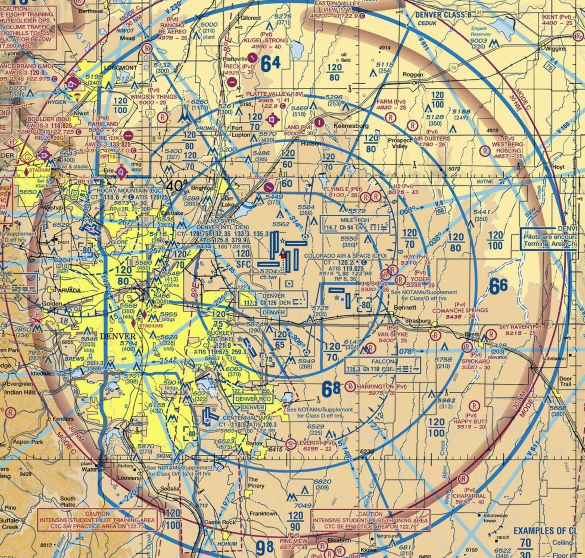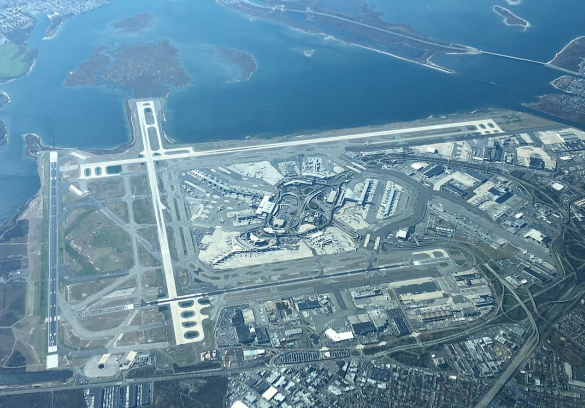Class B, or Class Bravo Airspace, is the biggest class of airspace that exists around an airport.
It is reserved for only the biggest and busiest of airports, the realm of the passenger and cargo jets.
In many ways it is also the most restrictive, with certain barriers to entry for many types of planes and pilots.
It is also the most complicated class of airspace, with several different layers and layouts, tailor made for each airport and other supporting factors.
What exactly is Class B Airspace, where does it reside, what are the weather minimums, and what other requirements are there to enter?
Keep reading to find out everything you need to know about this particular class of airspace!
1. What is Class B Airspace?

Class B Airspace is one of the 5 classes of controlled airspace.
It normally extends vertically from the surface up to 10,000ft MSL, with a few exceptions, such as Denver and Atlanta.
The ceiling of the Denver Class B Airspace extends up to 12,000ft MSL due to the high altitude of the airport.
The ceiling of the Atlanta Class B Airspace is 12,500ft MSL, and while the airport is at low elevation, Atlanta is the busiest airport in the country, requiring more restrictive airspace.
Laterally, Class B Airspace is laid out like an upside-down wedding cake, with several shelfs.
In general, the lowest part of the airspace is the area surrounding the airport, which goes from the ground up to the top of the Class B, and extends 10nm laterally.
The next shelf extends to around 20nm from the airport, and has a floor that is around 3,000ft above airport elevation.
The final shelf extends no more than 30nm from the airport, with a floor between 5,000 and 6,000ft above airport altitude.
Class B airports typically don’t exist on their own, and almost always have other, smaller airports located underneath the various shelfs.
Because of this, the different Class B shelves are almost never concentric circles, but have cutouts to allow for the other airports.
Sometimes, other controlled airports exist under the shelf, and the ceiling of their airspace ends at the beginning of the Class B shelf.
It’s depicted on the sectional chart with solid blue lines, and within the blue lines a pair of numbers, one on top of the other.
These numbers, also in blue, indicates the top and bottom of that part of the Class B shelf, the top number indicating the ceiling and the bottom number indicating the floor.
There is also a solid magenta circle on the sectional chart that extends 30nm out from the primary Class B airport.
This is the Mode C Veil, and within this area, a Mode C transponder with altitude reporting is required.
To enter into Class B airspace, a pilot must get specific clearance from Air Traffic Control, and a unique transponder squawk code must be used.
This is because ATC is required to provide separation within the airspace, although the pilot still has ultimate responsibility for collision avoidance.
If ATC tells the pilot to standby before entering, the pilot cannot enter Class B, even though he has established two-way radio contact.
This is different from Class C and D airspace, in which two-way radio contact is the only requirements to enter those airspace.
Some Class B Airspace have VFR corridors over or near the airport, and have specific operating requirements, which are normally found on the associated sectional charts.
Related Article – Class D Airspace Explained
2. Class B Airspace Weather & Visibility Requirements
The weather requirements for Class B Airspace is 3 statute miles visibility and clear of clouds.
However, most of the planes operating within Class B are on instrument flight plans, and the weather and visibility minimums are dictated by the IFR approach plates.
Some, but not all airports in this particular class of airspace will let a VFR pilot fly under SVFR rules, as long as visibility is at least 1 statute miles and the pilot remains clear of clouds.
3. Class B Equipment Requirements
A two-way radio is required to enter and operate within Class B Airspace.
In addition, an altitude reporting transponder with ADS-B Out is required to provide separation within the Class B.
An altitude reporting transponder with ADS-B Out is also required when operating within 30nm of the Class B airport but not within the Class B Airspace.
In this instance, a unique squawk code is not required, and VFR pilots can squawk 1200, the universal VFR code.
If flying underneath but not within Class B, contact with ATC isn’t required, but using Flight Following is recommended if ATC workload permits.
4. Class B Pilot Requirements
This particular airspace is the most restrictive for pilots, with a minimum requirement of a Private Pilot’s License (PPL).
There are some specific areas that student pilots can enter in Class B Airspace with certain endorsements, but even so, many of the largest airports prohibit students.
The Aeronautical Information Manual (AIM) has a list of the Class B airports that prohibit students.
Frequently Asked Questions (FAQ)
5. What is the speed limit in Class B?
Inside Class B Airspace, the speed limit is 250kts.
Underneath the airspace, or in a VFR corridor, the speed limit is 200kts.
6. What airspace is under Class B?
Unless there is another towered airport under a shelf, most of the airspace is Class E, while some of the airspace closest to the ground is Class G.
7. Can a student pilot fly into Class B?
In general, no. Certain parts of Class B can be entered by students with an endorsement, but many airports prohibit student pilots as a rule.
8. Can you fly a drone in Class B?
In general, no. Recreational drones are prohibited from flying in Class B Airspace.
Certain certified drone pilots, operating under Part 107 rules, may request clearance by using the LAANC (Low Altitude Authorization and Notification Capability) system.
The LAANC system is an app that drone users can use to apply for permission to fly within controlled airspace.
There is a limit to the number of airports that use the LAANC system, but it is available at 726 airports.
Conclusions
Class B Airspace surrounds the nations busiest airports, and therefore have the most restrictive requirements to enter.
A two-way radio and altitude reporting transponder with ADS-B Out are required, and specific permission must be obtained before entering.
Generally, Class B Airspace extends from the altitude of the airport up to 10,000ft MSL.
Laterally, it normally contains three different areas of airspace, laid out like an upside-down wedding cake.
The bottom shelf is normally a cylinder, extending 10nm away from the airport, and going from the surface to the ceiling.
The next shelf extends 20nm from the airport, and has a floor around 3,000ft above airport altitude.
The third shelf extends 30nm, with a floor around 6,000ft above airport altitude.
The airspace is rarely uniform, with many cut-outs, depending on other surrounding airports and terrain.
There also exists a Mode C veil that extends 30nm from the airport in which nearly all aircraft operating within must have an altitude reporting transponder.
Within Class B, visibility requirements are 3 statute miles, while remaining clear of clouds.
With a few exceptions, only pilots with a Private Pilot’s License or greater can enter Class B Airspace.
This particular airspace is typically the domain of jets, and working with ATC is a must to ensure safe and compliant flight within.
This doesn’t mean that General Aviation bug-smashers aren’t allowed, but often times it’s better for the smaller planes to avoid the large airports and pick something smaller.
Still, every pilot should know about and understand this type of airspace, as it is an essential part of the national airspace system.
References
https://www.faa.gov/regulations_policies/handbooks_manuals/aviation/airplane_handbook/
https://www.faa.gov/air_traffic/publications/atpubs/pham_html/chap15_section_2.html


